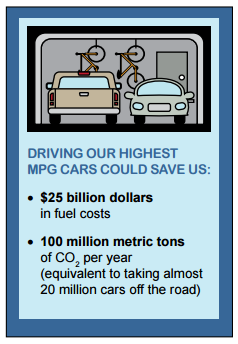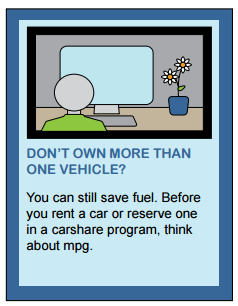What if We Drove Our Most Efficient Car?
 A powerful weapon to tackle climate change may already be parked in your garage. Almost 60% of U.S. households own more than one vehicle.1 We all know driving our cleanest, most efficient car pollutes less and saves us money at the pump. So why do we sometimes hop in our less efficient ride instead of our gas-sipping hybrid? It could be habit: you and your spouse may each have a preferred car that you drive regardless of who has the longer commute. Or maybe it’s practical: the infant car seat just fits better in the SUV, or you fear trusting your teenager with your new set of wheels. There are many factors that contribute to how we assign cars to household drivers on a given day. But what if people always chose to drive the most efficient car that meets their needs?
A powerful weapon to tackle climate change may already be parked in your garage. Almost 60% of U.S. households own more than one vehicle.1 We all know driving our cleanest, most efficient car pollutes less and saves us money at the pump. So why do we sometimes hop in our less efficient ride instead of our gas-sipping hybrid? It could be habit: you and your spouse may each have a preferred car that you drive regardless of who has the longer commute. Or maybe it’s practical: the infant car seat just fits better in the SUV, or you fear trusting your teenager with your new set of wheels. There are many factors that contribute to how we assign cars to household drivers on a given day. But what if people always chose to drive the most efficient car that meets their needs?
What's the bottom line?
One study estimated we could cut fuel consumption 10% by switching to our highest mpg car when feasible.2,3 That’s because there’s often a sizable gap between the most and least efficient vehicles in our garages. And households with more vehicles tend to have a larger gap, so those families could save even more fuel.
There are 65 million multi-vehicle households in the United States. Each of these households drives an average of 28,000 miles per year.1 If each one reduced fuel consumption by 10%, we’d need about 10 billion fewer gallons of gasoline each year.4
What does that mean for our wallets? Assuming $2.50/gallon of gasoline, we’d save over $25 billion in fuel costs. We’d pollute less, too. Driving our highest mpg cars more could prevent almost 100 million metric tons of tailpipe CO2 emissions, equivalent to taking almost 20 million cars off the road.
What would it be like?
Families would save an average of $400 at the pump each year from driving their higher mpg car more—enough to buy a lot of groceries. Of course, the impact on your wallet will depend on your household’s vehicles and driving habits. Consider these examples:
Case 1: Nicole drives a 14 mpg SUV for her 20-mile trip to a suburban office park while her husband takes their 20 mpg sedan to work at a local bank 10 miles away. If, instead, she drove the more efficient car for her commute, they would save over $250 a year (assuming they work 5 days a week, 50 weeks a year).
Case 2: Emily drives a 17 mpg minivan to her high school hockey practice 10 miles away every Saturday. Switching to her family’s 45 mpg hybrid would save about $100 per year (assuming she goes to practice every week). That’s enough to throw a pizza party for her team.
Tips to get started
It can be a hassle to change our routines, but prioritizing mpg can have a big impact.
- Think about your regular trips first. Can you ditch the low mpg option for the longer commute, school drop-off, or other routine activities?
- When your kids ask which car they can borrow, consider whether they’re driving across town or across state lines. Let them take the high mpg car for longer drives.
- Opt for the more fuel efficient vehicle for long-distance trips. You can use the fuel savings to buy Grandma some chocolates.
- When considering your next vehicle purchase, think about how much capacity you actually need. Perhaps both vehicles don’t have to fit the entire basketball team.
- Looking for something to talk about at the breakfast table? Why not compare schedules and challenge your family to share cars in a way that minimizes household gasoline use.
Already putting the most miles on your most efficient car? Next time you’re car shopping, look for an even higher mpg vehicle to park in your garage. Visit our vehicle search page to find the most efficient cars that meet your needs.
A PDF version of this page, optimized for printing
What If We Drove Our Most Efficient Car? (PDF)(2 pp, 310 K, EPA-420-F-15-022, June 2015, About PDF)
- U.S. Department of Transportation, Federal Highway Administration, 2009 National Household Travel Survey. URL: http://nhts.ornl.gov/
- Bolon, Kevin M., Gregory A. Keoleian, and Lidia P. Kostyniuk. Fuel Use and Optimality of Assignments in Multi-vehicle Households in 2001 and 2009, Transportation Research Record: Journal of the Transportation Research Board, No. 2382, Transportation Research Board of the National Academies, Washington, D.C., 2013, pp. 83–91. DOI: 10.3141/2382-10.
- The study considered it feasible to switch to a more fuel efficient household vehicle if the vehicle is available for the trip, or series of trips, at the scheduled time and is able to seat all passengers. It did not account for cargo requirements.
- We assumed an average fuel consumption of 5.9 gallons/100 miles for multi-vehicle households. This was calculated using values provided in the study and an assumption of 55% city driving and 45% highway driving.
